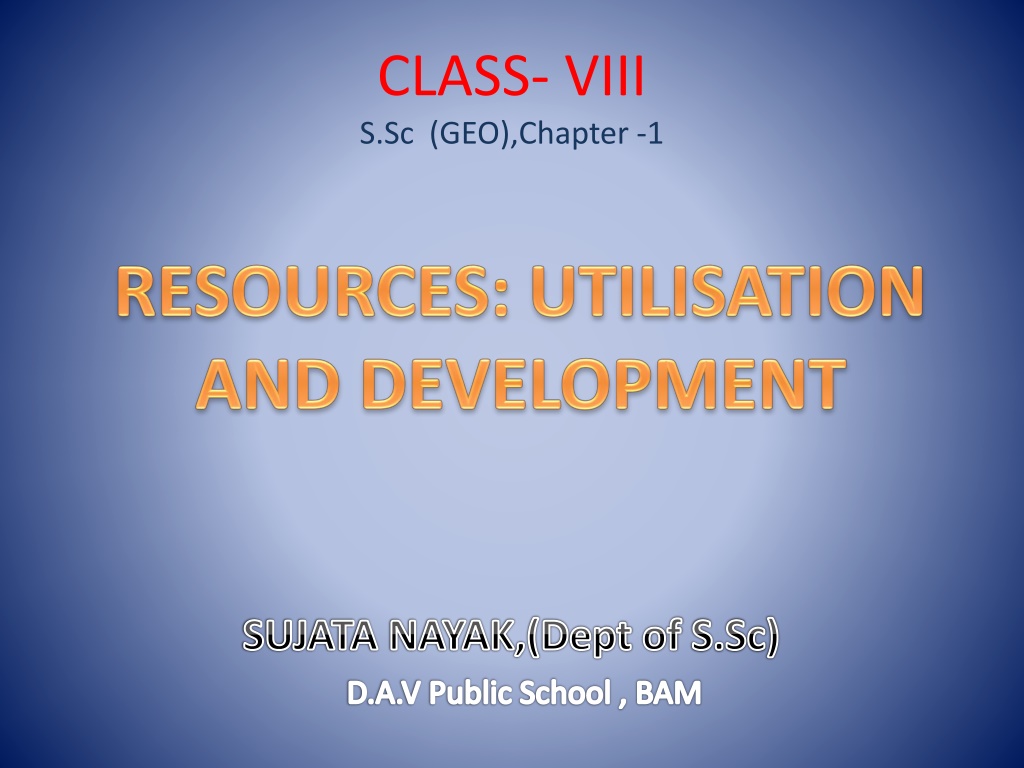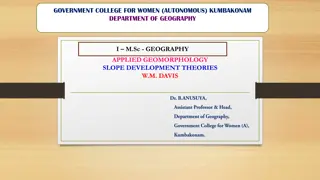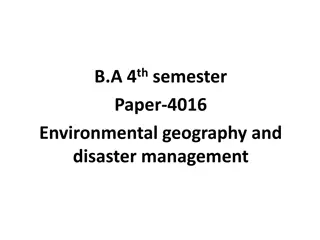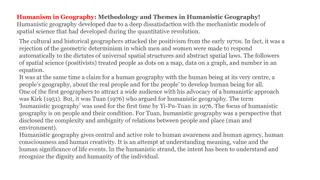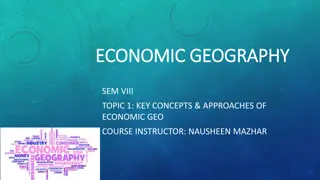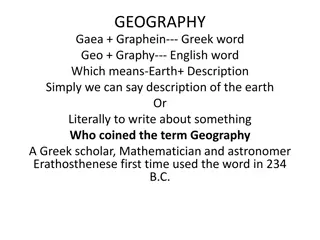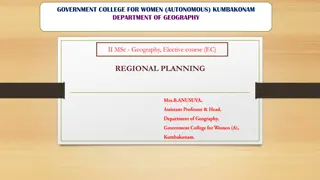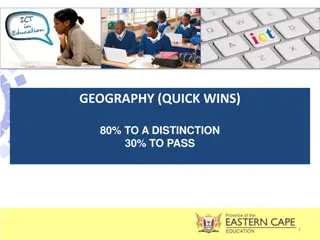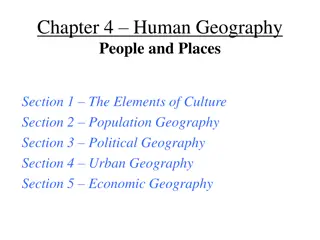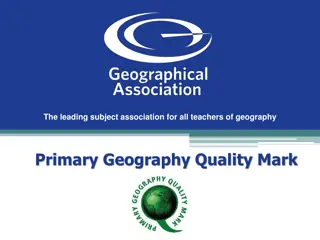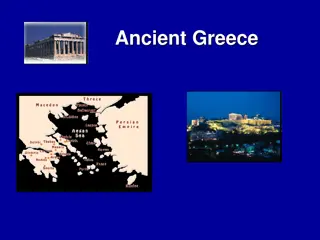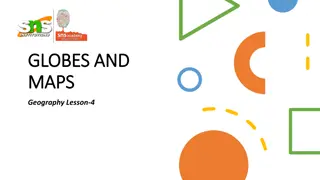Understanding Resources in Geography: A Comprehensive Overview
Resources are essential for our existence, ranging from basic needs like air and water to technological advancements. Their utility and value vary by time and place, shaping human civilizations and development. The utilization of resources depends on factors like availability, skills, technology, and more. Classification based on renewability distinguishes between renewable and non-renewable resources, highlighting the importance of sustainable practices for the future.
Download Presentation

Please find below an Image/Link to download the presentation.
The content on the website is provided AS IS for your information and personal use only. It may not be sold, licensed, or shared on other websites without obtaining consent from the author. Download presentation by click this link. If you encounter any issues during the download, it is possible that the publisher has removed the file from their server.
E N D
Presentation Transcript
CLASS- VIII S.Sc (GEO),Chapter -1 SUJATA NAYAK,(Dept of S.Sc) D.A.V Public School , BAM
Resources : Utilisation and Development RESOURCES- All the things present on earth ,which are necessary for our existence on this planet are called as Resources. We need air to breathe, water to drink and food to eat. We use these gifts of nature to fulfill our day to day needs. Some resources can become economically valuable with time. Even human beings are considered as resource . Time and technology are the important factors that change substances into people . People themselves are the most important resource. It is their ideas, knowledge, inventions and discoveries that lead to the development of other resources. Each discovery or invention leads to many others. For example- 1.Discovery of fire led to the practice of cooking 2.Invention of the wheel resulted in the development of newer modes of transport.
Utility and Value of resource from time to time and place to place : Human needs and wants are neither uniform in all parts of the world nor static over the years. In ancient times , emphasis was mainly given on satisfying the basic needs like food , clothing , shelter which was derived from the natural environment but in advanced societies greater emphasis is laid on the utilization of resources for satisfying the multi needs of human beings. Utility and value of resources varies from time to time and place to place . Earlier human civilizations flourished along the river valleys as they used water for irrigating fields. Now human beings are using water for generating energy , Irrigation , navigation , Industries , etc. China and U.S.A are generating more wind energy than India
Utilisation of Resources: Resources become usable when they are processed . For example, cotton is converted into yarn. On further processing , it is converted into fabric ,then finally into garments. Generally, the utilisation of resources depends upon various factors , such as: Availability of resources Skill of human beings Availability of Capital Availability of water Advancement of technology(tools , machines, etc.) Availability of transport and communication facilities, etc. U.S.A is termed as a developed country because it is economically self-sufficient and technologically advanced . On the other hand , India is still in a developing stage. Though resources are essential for development , but their mere presence doesn t guarantee development . Other factors also play a crucial role.
Classification of Resources: CLASSIFICATION OF RESOURCES ORIGIN OCCURRENCE DEVELOPMENT RENEWABILITY BIOTIC ABIOTIC NATURAL MAN-MADE POTENTIAL NON-RENEWABLE ACTUAL RENEWABLE
Classification Based on Renewability: RENEWABLE RESOURCES: Resources, which can be renewed either naturally or by human efforts , are known as Renewable resources. Renewable resources are also known as inexhaustible resources. For example , solar energy air and water. They are found in plenty. They are Eco-friendly. NON-RENEWABLE RESOURCES: Resources, which cant be renewed or take longer period to form or to renew are known as non-renewable resources. They are also known as Exhaustible resources. For example, coal ,petroleum and natural gas. They are limited on Earth . In future, there will be a great scarcity. Utilisation of these resources may cause adverse effect in the environment.
On the basis of Origin: On the basis of Renewability:
Classification Based on Origin: BIOTIC RESOURCES: Resources , which are obtained from biosphere and have life(living beings), are known as Biotic Resources. They have the capacity to reproduce and regenerate. All biotic resources are renewable , but some take a long period of time to be renewed, for example the forests. For example, birds, animals, fish, forests ,etc. ABIOTIC RESOURCES: All non-living resources are known as Abiotic Resouces. The abiotic resources are not renewable except water which is inexhaustible. These resources are in great demand for the development of various industries and agriculture. For example, land, water, minerals, etc.
Classification Based on Occurrence: NATURAL RESOURCES: Resources ,available from nature in form of water ,minerals ,forests ,etc. , and used by human beings to satisfy their needs ,are known as Natural Resources. These resources are essential for the survival of human beings and form the base for the development of a country. For example, water ,land ,forest ,etc. MAN-MADE RESOURCES: Resources created by human beings to satisfy their needs are known as Man-made Resources. These resources are essential for us, but they are also developed from natural resources. For example, roads, buildings, machines, etc. The quality and quantity of people of a country determine its human resource . Healthy and well educated people contribute to their respective society in positive ways. Malnourished and illiterate people ,on the other hand ,cant contribute much to their societies . Example , Japan is a developed country because people are skilled and technically developed whereas African nations, inspite of being rich in resources, are less developed as most of the people are unskilled and illiterate .
On the basis of Occurrence: On the basis of Development:
Classification Based on the Development of the Resources: POTENTIAL RESOURCES: Available resources in a country, which are not fully tapped, are known as Potential Resources. These resources need detailed survey for estimating their quantity and quality. For example ,Arctic sea-bed may hold as much as 25% of the world s undiscovered oil and natural gas reserves. ACTUAL RESOURCES: The actual resources of a country are those which have been thoroughly surveyed and their quantities have been ascertained. The exploration ,development and utilisation of an actual resource depends upon the technology available. For example ,Saudi Arabia has 25.9% of the world oil reserves.
Sustainable Development and Conservation: SUSTAINABLE DEVELOPMENT: Sustainable development means development that takes place without damaging the environment . SUSTAINABLE DEVELOPMENT IS THE NEED OFHOUR ,because: It meets the need of the present without compromising the needs of future generation. Most of the resources are limited in their supply. Over-use of many valuable resources has led to their degradation or deterioration in quality. Distribution of resources across the world is highly uneven. Rapid population growth has resulted in over- utilisation of the natural resources.
CONSERVATION: Conservation means sustainable and optimum utilisation of resources. We must realise that nature and its resources are not merely ours . They also belong to the future generation. Therefore ,it is essential that we: Use all renewable resources judiciously. Minimise the depletion of natural resources. Conserve the varied species. Development of technology ,human skill and population control is essential for a long-term sustainability of natural resources Follow 6 R s i.e reuse, reduce , recycle , refuse ,repair and rethink . Use the resources according to the need , not greed .
Extra Questions : Name the developed Asian Country which use more wind energy than India? Human Resources are well developed in Japan, Why? Give one reason. Give an example of actual resourceful country? Define natural resource with an example. USA is termed as a developed country. Give one reason. Human being considered as a resource why? Give one reason. Highlight the advantages of sustainable lifestyle . Technological advancement is a boon as well as ban to human civilization , Explain the statement with an example of each. Suggest any five ways to reduce the wastage of resources .
